-
Producing ‘green methane’ with artificial photosynthesis
A solar-powered catalyst uses artificial photosynthesis to turn carbon dioxide into methane. We could be recycling smokestack CO2 within 5-10 years, researchers say.
-
Peering into biological tissue
A light-spinning device inspired by the Japanese art of paper cutting allows U-M researchers to scan the internal structures of plant and animal tissue without X-rays
-
Easy rider? Not always
After years working in Silicon Valley, Levi Weintraub, BSE ’06, dreamed of ditching his job as a software engineer, hopping on a motorcycle, and exploring Africa. So he did. After logging some 42,000 miles, he says, ‘Humanity was the biggest revelation for me.’
-
Built by humans, ruled by computers
As algorithmic decision-making becomes more powerful, researchers cite concerns that computers don’t always know — or do — what’s best for we humans.
-
Gonna fly now
With its outdoor fly lab for drone testing, U-M now hosts advanced robotics facilities for land, air, sea, and space. Plus: Robotics building breaks ground.
-
Noble Nobel in space
In 1976, Samuel C.C. Ting discovered a particle that changed physics. In 2018, he’s working on the most sophisticated particle physics experiment in space.
-
Cybersecurity in self-driving cars
Mcity report gives new insights into automated vehicle vulnerabilities, threats.
-
Thruster for Mars mission breaks records
U-M engineers develop advanced space engine to propel humans to Mars; it’s breaking records for operating current, power, and thrust.
-
The courage to resist
In the escalating struggle between the individual and the state technology favors the powerful. That’s why this computer scientist revels in righting the balance.










